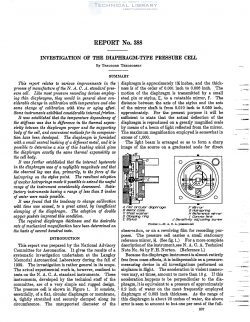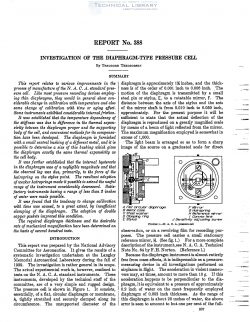naca-report-388

- Version
- 120 Downloads
- 1.55 MB File Size
- 1 File Count
- August 26, 2016 Create Date
- August 26, 2016 Last Updated
National Advisory Committee for Aeronautics, Report - Investigation of the Diaphragm Type Pressure Cell

This report relates to various improvements in the
process of manufacture of the N. A. C. A. standard pres-
sure cell. Like most pressure recording devices employ—
ing thin diaphragms, they would in general show con-
siderable change in calibration with temperature and also
some change of calibration with time or aging eject.
Some instruments exhibited consMerable internal friction.
It was established that the temperature dependency of
the stiflness was due to diference in the thermal expan—
sii‘ity between the diaphragm proper and the supporting
body of the cell, and conrenient methods for its compensa-
tion have bee-n developed. The diaphragm is furnished
with a small central bushing qf a diferent metal, and it is
possible to determine a size of this bushing which gives
the diaphragm exactly the same thermal erpansicity as
the cell body.
It was further established that the internal hysteresis
in the diaphragm was of a negligible magnitude and that
the obsen‘ed lag was due, primarily, to the force of the
hairspring on the stylus point. The resultant adoption
of weaker hairsprings made it possible to extend the useful
range of the instrument considerably downward. Satis-
factory instruments having a range of less than 3 inches
of water were made possible.
It was found that the tendency to change calibration
with time was caused, to a great extent, by insuficient
clamping of the diaphragm. The adoption of double
copper gaskets improved this condition.
The reguired diaphragm thickness and the desirable
rate of mechanical magnification hare been determined on
the basis of several hundred tests.
This report was prepared by the National Advisory
Committee for Aeronautics. It. gives the results of a
systematic investigation undertaken at the Langley
Memorial Aeronautical Laboratory during the fall of
1929. The investigation is rather general in its scope.
| File | Action |
|---|---|
| naca-report-388 Investigation of the Diaphragm Type Pressure Cell.pdf | Download |

Comment On This Post